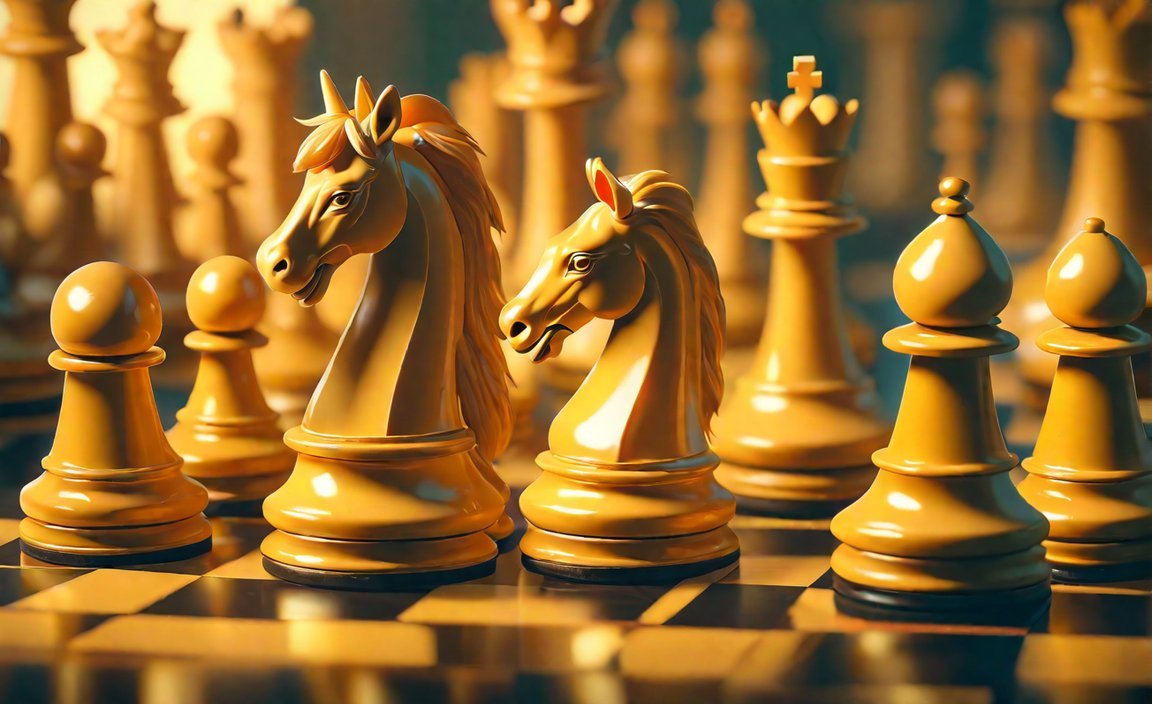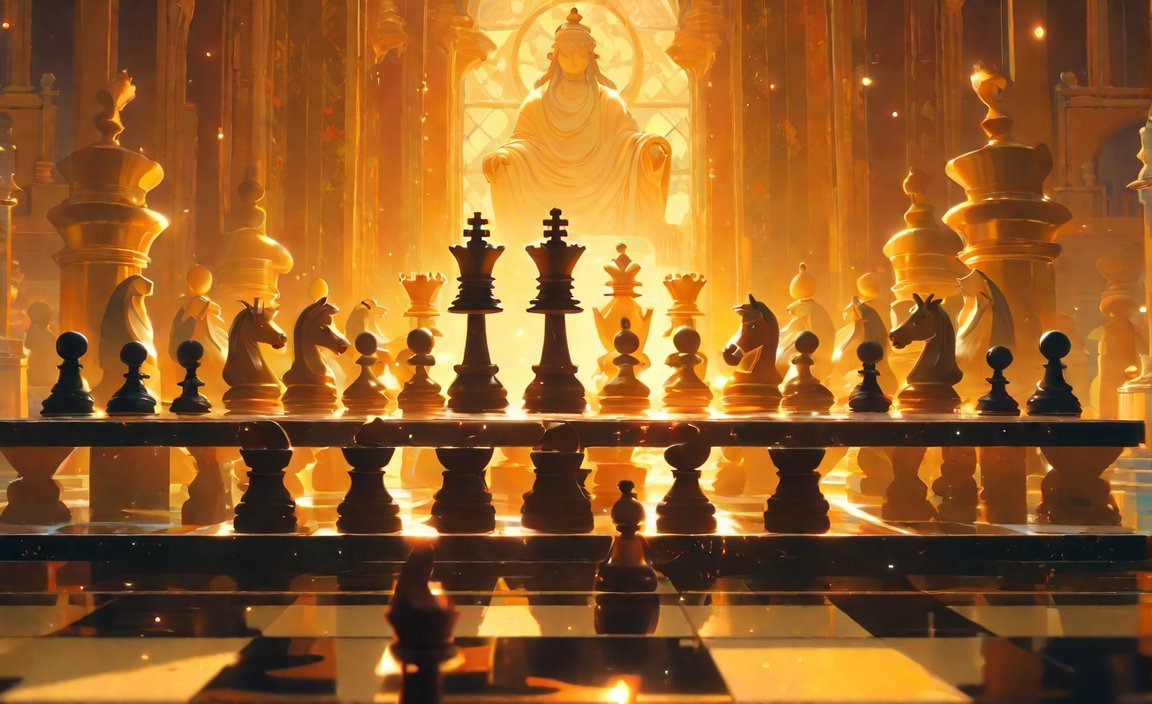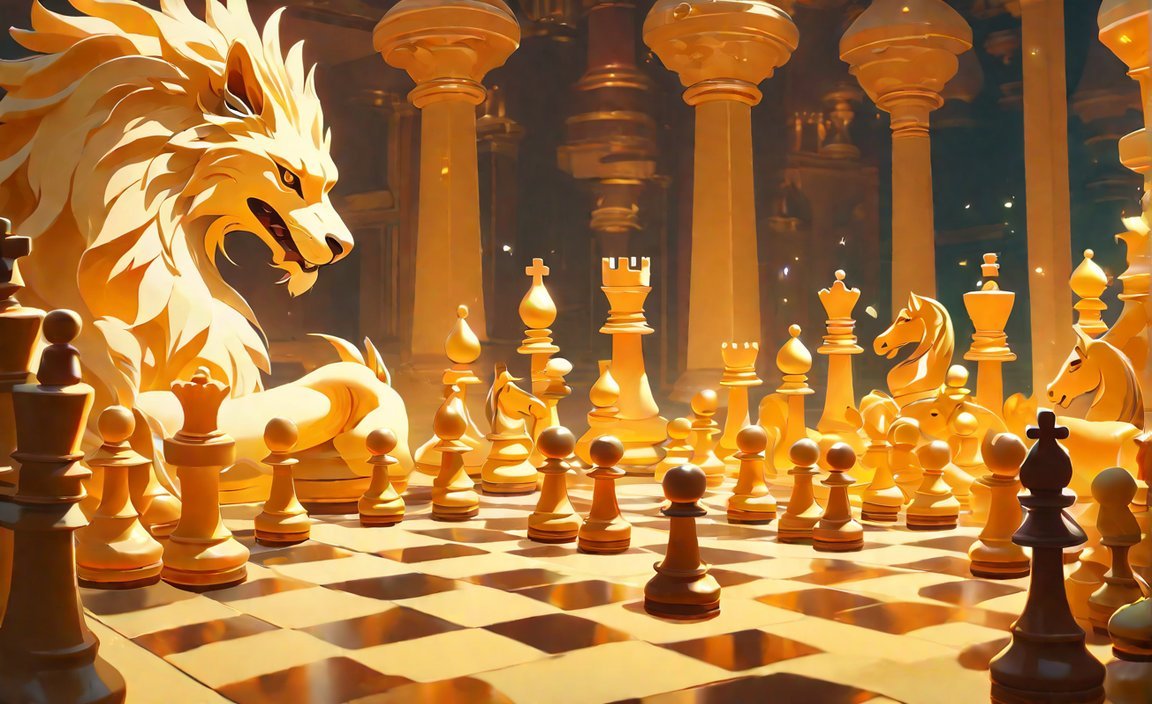Unveiling Intriguing Facts: Explore the Rich Chess World! Delve into the captivating realm of chess as we uncover a treasure trove of fascinating facts and untold stories. Join us on a journey through the intricate tapestry of this ancient game, as we unravel its history, unravel its strategies, and unlock its hidden secrets. Whether you are a seasoned chess player or a curious novice, prepare to be immersed in the wealth of knowledge and intrigue that lies within the world of chess. From the origins of the game to the most brilliant moves ever played, this exploration of facts on chess offers a captivating glimpse into a timeless pursuit of strategy and intellect.

Key Takeaways:
- The maximum number of moves in a chess game is theoretically 5,949.
- A priest who was prohibited from playing chess created a folding chessboard disguised as books.
- Chess has over 319 billion possible combinations, showcasing its complexity.
- The longest chess game ever played lasted 269 moves and ended in a draw.
- The rook piece in chess is called “rohk” in Persian, meaning “chariot.”
Facts on Chess
Are you ready to delve into the captivating world of chess? In this article, we will explore some intriguing facts that will shine a light on the rich and diverse aspects of this timeless game.
The Complexity of Chess:
Chess is known for its complexity and depth, and the numbers speak for themselves. Did you know that there are over 319 billion possible combinations in chess? That’s right, the sheer number of potential moves and strategies is mind-boggling. This highlights the immense scope for creativity and strategic thinking that chess offers.
The Limitless Chess Board:
When it comes to chess, there seems to be no limit to the possibilities. According to chessjournal.com, the chess board theoretically has a maximum of 5,949 moves. This means that a game of chess can potentially go on for a staggering number of moves. It’s incredible to think about the countless variations and decisions that players can make.
The Folding Chessboard:
Chess has endured the test of time, but there was a period when it faced opposition from religious authorities. It is fascinating to learn that a priest, who was forbidden from playing chess, created the folding chessboard. This clever invention allowed him to hide the chessboard by disguising it as two books when folded up and placed on a shelf. This story reveals the ingenious ways people found to indulge their passion for the game, even in the face of restrictions.
The Story of the Rook:
Chess pieces have their own intriguing histories. Take the rook, for example. This powerful piece, resembling the turret of a castle, gets its name from the original Persian word “ruhk,” which means “chariot.” Just like a chariot was a symbol of strength and mobility in ancient times, the rook symbolizes dominance and control on the chessboard.
The Epic 269-Move Game:
Chess has witnessed countless intense battles, but one game stands out for its duration and complexity. In Belgrade in 1989, a game between I. Nikolic and Arsovic lasted a mind-boggling 269 moves. This record-breaking game ended in a draw, showcasing the resilience and strategic prowess of the players involved. It serves as a testament to the endurance and mental stamina required to navigate the twists and turns of a lengthy chess match.
Every fact reveals a unique facet of chess, offering a glimpse into its popularity, strategic nature, and the fascinating tales that surround it. It’s no wonder that chess has captivated the minds of millions, inspiring them to challenge themselves and engage in this timeless game.
So, the next time you sit down for a game of chess, keep these intriguing facts in mind. Appreciate the complexity, embrace the possibilities, and relish the rich history that chess brings to life on the 64 squares of the board. Chess is like a symphony of intellect and strategy, where every move and decision matters. Happy playing!
Remember, chess is not just a game—it’s a never-ending journey of exploration, self-improvement, and discovery. Let the magic of chess continue to enchant you as you explore the depths of its intricate world.
Challenge yourself, engage your mind, and unlock the countless possibilities that lie within the bounds of the chessboard. The world of chess awaits you!
Check out these interesting facts about Albania!
Bobby Fischer: The Youngest Chess Grandmaster in History
As we delve into the captivating world of chess, one name stands out among the rest – Bobby Fischer. This enigmatic figure not only left an indelible mark on the chessboard but also etched his name in the history books. At the young age of 15, Bobby Fischer became the youngest Grandmaster in the history of chess, an achievement that still resonates with chess enthusiasts to this day.
But who exactly was Bobby Fischer? Born on March 9, 1943, in Chicago, Illinois, Fischer’s extraordinary talent was recognized from an early age. He first gained attention when he won the United States Junior Chess Championship in 1956 and again in 1957. These victories set the stage for his groundbreaking ascent in the world of chess.
In 1958, at the tender age of 15, Fischer clinched the title of Grandmaster, making him the youngest to achieve this feat at the time. This remarkable accomplishment catapulted him into the spotlight and solidified his reputation as a prodigious talent. Fischer’s journey to greatness had only just begun.
His meteoric rise continued in 1959 when he won his first of a record-breaking eight United States Championships at the age of 14. Just one year later, in 1964, Fischer achieved a historic milestone in the chess world. He won the US Championship with a perfect score of 11-0, a feat that has never been replicated. This flawless performance cemented Fischer’s dominance and set the stage for his future triumphs.
In 1972, Bobby Fischer faced his ultimate challenge – the World Championship match against Boris Spassky. The cold war tensions between the United States and the Soviet Union added an extra layer of intrigue to the battle on the chessboard. Fischer proved himself to be more than a worthy opponent, defeating Spassky and becoming the first American-born World Chess Champion.
Throughout his career, Fischer’s eccentric personality and unyielding pursuit of perfection often overshadowed his phenomenal talent. He was known for his intense dedication to the game and his unrelenting pursuit of strategic excellence. Chess was not merely a game to Fischer; it was a way of life.
Many consider Bobby Fischer to be the greatest chess player of all time, and his impact on the world of chess continues to be felt today. His contributions to the game go far beyond his extraordinary achievements. Fischer’s unique style of play, unwavering determination, and unwavering pursuit of success have inspired generations of chess enthusiasts worldwide.
Sadly, Bobby Fischer passed away on January 17, 2008, leaving behind a legacy that will forever be etched in the annals of chess history. His extraordinary journey serves as a testament to the power of passion, dedication, and the indomitable human spirit.
Key Takeaways:
– Bobby Fischer became the youngest Grandmaster in the history of chess at the age of 15 in 1958.
– He won eight United States Championships, including one with a perfect score of 11-0.
– Fischer defeated Boris Spassky in 1972 to become the first American-born World Chess Champion.
– Despite his eccentricity, many consider Fischer the greatest chess player of all time.
Sources:
– Encyclopedia Britannica: Bobby Fischer | Biography & Facts
– Wikipedia: Bobby Fischer
The Highest Chess Rating Achieved: Magnus Carlsen’s Record-Breaking Achievement
Magnus Carlsen, a Norwegian Grandmaster, holds the distinction of achieving the highest recorded chess rating ever. With a peak rating of 2882, Carlsen’s remarkable accomplishment has solidified his position as one of the greatest chess players of all time[^1^]. This extraordinary rating was attained in May 2014, after an exceptional performance at the Shamkir Chess tournament held in Azerbaijan.
During the tournament, Carlsen displayed his exceptional skills, winning the competition and securing victories against grandmaster opponents. His impressive display of strategic prowess and tactical acumen propelled him to unprecedented heights in the chess world[^1^]. Carlsen’s achievement of a stunning rating of 2882 remains untouched, underscoring his dominance and excellence in the game.
Carlsen’s exceptional rating is not limited to his peak of 2882. Earlier in April 2014, his live rating reached an astounding 2889.2, further highlighting his unparalleled mastery in classical chess[^1^]. These incredible ratings stand as a testament to Carlsen’s immense talent, dedication, and profound understanding of the game.
When it comes to chess, improving one’s rating is a common aspiration for players at all levels. Strategies to enhance gameplay include seeking guidance from a chess coach, studying tactics and strategies, and actively engaging in tournaments. By challenging oneself against stronger opponents, players can gain valuable experience and sharpen their skills, ultimately contributing to rating improvement^2^.
While Carlsen’s record-breaking rating sets an unprecedented benchmark, it’s worth noting that the lowest FIDE rating ever recorded varies, dependent on individual players and specific circumstances^2^. However, it’s important to remember that the FIDE rating system commences at a baseline value of 1000^2^. Hence, it is possible for a player’s rating to dip below this threshold.
The FIDE rating system is meticulously designed to measure the relative strength of chess players. This rating is calculated based on game results against other rated players. The system takes several factors into account, including opponents’ ratings, game outcomes, and time controls. These elements collectively determine changes in a player’s rating^2^.
In summary, Magnus Carlsen’s unrivaled achievement of the highest recorded chess rating, a staggering 2882, in May 2014, stands as a testament to his exceptional talent and mastery of the game. His awe-inspiring performance at the Shamkir Chess tournament catapulted him to legendary status in the chess world[^1^]. Aspiring chess players endeavor to improve their ratings by seeking guidance, studying tactics and strategies, and engaging in challenging competitions^2^. Carlsen’s remarkable feat offers aspiring players and chess enthusiasts alike a glimpse into the incredible heights that can be reached through relentless dedication and unparalleled skill.
Key Takeaways:
– Magnus Carlsen holds the record for the highest recorded chess rating with a peak rating of 2882[^1^].
– Carlsen achieved this remarkable feat in May 2014 after an outstanding performance at the Shamkir Chess tournament in Azerbaijan[^1^].
– Improving one’s chess rating can be achieved through seeking coaching, studying tactics and strategies, and participating in tournaments^2^.
– The FIDE rating system considers various factors, including opponents’ ratings, game outcomes, and time controls, to calculate a player’s rating^2^.
Citations:
[^1^]: Guinness World Records. (n.d.). Highest chess rating ever attained. Retrieved from
Unveiling Intriguing Facts: Explore the Rich Chess World!
The First World Chess Championship and Wilhelm Steinitz’s Triumph
The world of chess is full of captivating stories and fascinating moments, and one of its defining moments took place in 1886. It was during this year that the first official World Chess Championship was held, forever changing the landscape of this ancient game. The champion who emerged from this historic event was Wilhelm Steinitz, a name that would become synonymous with skill, innovation, and strategic ingenuity.
The competition, held between Steinitz and Johannes Zukertort, spanned from January 11 to March 29, 1886. Games were played not only in New York City but also in St. Louis and New Orleans, marking the first time such a prestigious championship was taken on an American tour.
Before this groundbreaking event, the world of chess lacked a formal system for determining its champion. Matches were organized privately between the reigning champion and their challenger, leaving room for ambiguity and creating a desire for a more structured approach.
Steinitz, a genius in his own right, had already made significant contributions to the game leading up to the championship. From 1873 to 1882, he went on a remarkable winning streak, introducing a revolutionary style of play that would later be known as positional chess. This methodology focused on strategic maneuvering and long-term planning, challenging the prevalent aggressive approach of the time. Thus, Steinitz is rightly celebrated as the father of positional chess and one of the greatest players in history.
His victory in the first official World Chess Championship solidified his status as the world champion, a title he held from 1886 to 1894. Steinitz’s strategic prowess and analytical thinking shaped the concept of a world chess champion, setting the stage for future icons to follow in his footsteps.
Since Steinitz’s triumph in 1886, the World Chess Championship has seen a succession of remarkable champions. Names like Emanuel Lasker, Jose Raul Capablanca, Alexander Alekhine, Max Euwe, Mikhail Botvinnik, and Vasily Smyslov have all made their mark on the chess world and contributed to its rich tapestry. The title of world champion is now determined through organized matches and tournaments orchestrated by the World Chess Federation (FIDE).
To further delve into the World Chess Championship of 1886 and immerse yourself in the fascinating journey of Wilhelm Steinitz, you can explore these sources for additional information:
Key Takeaways:
- The first official World Chess Championship was held in 1886, leading to a more organized and structured approach to determining the world champion.
- Wilhelm Steinitz emerged as the victor, becoming the inaugural world champion and introducing positional chess as a groundbreaking strategic concept.
- Steinitz’s style of play challenged the prevailing aggressive approach of the time and showcased the power of long-term planning and strategic maneuvering.
- Steinitz’s victory shaped the concept of a world chess champion and set the stage for subsequent players to vie for this prestigious title.
- The World Chess Championship has seen an illustrious lineage of champions, each contributing their unique skills and making their mark on the chess world.

FAQ
Q1: What is the theoretical limit of moves in a game of chess?
A1: According to chessjournal.com, the theoretical limit of moves in a game of chess is 5,949.
Q2: Who created the folding chessboard?
A2: The folding chessboard was created by a priest who was prohibited from playing chess. He disguised the chessboard as two books when folded up and placed on a shelf.
Q3: How many possible combinations are there in chess?
A3: Chess.com states that there are over 319 billion possible combinations in chess, highlighting the complexity and depth of the game.
Q4: What is the longest chess game ever played?
A4: The longest chess game ever played lasted 269 moves and ended in a draw. It took place between I. Nikolic and Arsovic in Belgrade in 1989.
Q5: Why is the rook called a “rook”?
A5: The rook got its name from the original Persian name for the piece, “ruhk,” which means “chariot.” The piece resembles a turret of a castle.
- Senior at What Age: Benefits & Eligibility Guide - March 29, 2025
- Unlocking Senior Benefits: How Old is a Senior? Your Complete Guide - March 29, 2025
- Master Russian Politeness:A Guide to Saying Please - March 29, 2025
















